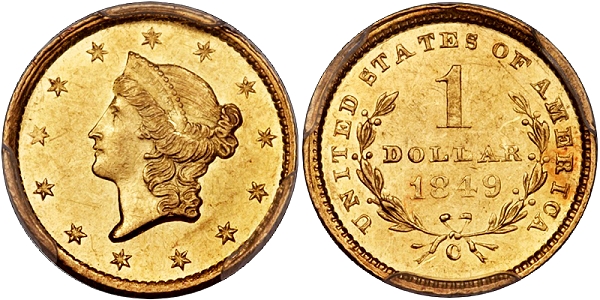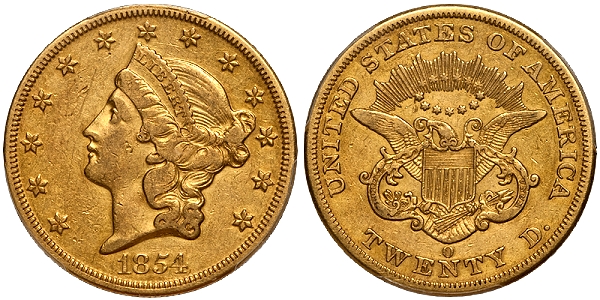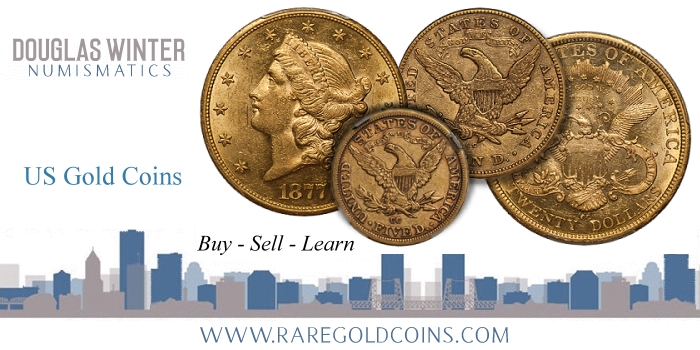By Doug Winter – RareGoldCoins.com ……
CoinWeek Content Partner ……
In the Heritage February 2018 sale of the Admiral Collection, the star attraction was a nice NGC AU50 example of the 1875 eagle. I purchased this coin for $372,000 USD, which is an all-time auction record for this issue. In my opinion, the 1875 eagle is still undervalued when compared to other classic rarities that were produced as business strikes. I’d like to build a case for the 1875 by comparing it to a few other issues which currently sell for similar values–or more.

1875 $10.00 NGC AU50. IMAGE COURTESY OF HERITAGE
But first, a few sentences about the 1875 eagle. This coin has the lowest mintage figure of any Liberty Head eagle with just 100 made for circulation. There are likely as few as seven to nine pieces and this includes one very-low-grade piece (VG10) and one which is impounded in the Smithsonian. I am aware of four that grade AU, and the best of these is a PCGS AU53+. The Admiral coin was the second best I have seen and it was notable for its originality and overall lack of detracting marks. The 1875 is (by far) the rarest Liberty Head eagle and its rarity is not fully realized outside of the specialist community.
Now, on to the comparisons.
1. 1849-C Open Wreath Gold Dollar

1849-C OPEN WREATH $1.00 PCGS MS62. IMAGE COURTESY OF HERITAGE
There are exactly five known examples of this variety and given that none have turned up in decades, it is likely that no more exist. The 1849-C OW is clearly rarer than the 1875 eagle and it is a legitimate issue, made for circulation.
There are a few important factors working against this issue.
The first is that it is technically a variety and since there are Closed Wreath 1849-C gold dollars, a viable (and much less expensive) alternative exists for gold dollar collectors.
The second is this coin’s size. It takes a pretty big leap of faith to spend a mid-six figure sum on such a small coin.
The third is the relative unpopularity of Gold Dollars, especially in comparison to the 10-dollar denomination.
There is a private treaty sale for the finest-known 1849-C Open Wreath gold dollar (a PCGS MS62, formerly graded MS63 by NGC) at close to $1 million, and three auction records for the same coin at $690,000 (2004), $493,500 (2015), and $528,750 (2016). In 2010, another example, this one graded EF45 by NGC, brought $218,500.
If we assume that an EF 1849-C Open Wreath is worth $200,000-250,000 and that an AU is worth $300,000-400,000+, then I’d say that a Condition Census AU50 1875 eagle is well undervalued.
2. 1854-S Quarter Eagle

1854-S $2.50 PCGS VF35. Images courtesy Douglas Winter Numismatics
After years of neglect, the 1854-S was recognized as a Classic American Rarity about a dozen years ago; more specifically, when I bought the Lee Family example (graded EF45 by NGC) for $253,000 in September 2005. Since then, prices have been very strong and this is best exemplified by a Good 6 selling for $193,875 in March 2014. I had sold the exact same coin 15 years ago for $35,000.
There are around a dozen 1854-S quarter eagles known from an original mintage of 246, so this issue is not as rare as the 1875 eagle and there is always the chance that one could turn up on the SS Central America. As with the 1875 eagle, the 1854-S quarter eagle is always seen in lower grades with the finest known grading PCGS AU50 and another three or four grading Extremely Fine.
If I were to ask a sophisticated gold coin collector if he would rather own an 1854-S quarter eagle or an 1875 eagle, I think the responses would be a 50/50 split. But the 1854-S is currently valued much higher. I’m guessing an EF would bring at least $350,000-400,000 (and likely more), while the PCGS AU50 would likely sell well north of the $500,000 mark. Given these estimates, I’d have to figure that the 1875 eagle is still undervalued.
3. 1854-O and 1856-O Double Eagles

1854-O $20.00 PCGS EF40
With an estimated 30-40 known, each of these dates are considerably less rare than the 1875 eagle. And given that the original mintages are 3,250 and 2,250 respectively, it is realistic to assume that a few more examples exist “in the wild”.

1856-O $20.00 PCGS AU55
Few Liberty Head gold coins saw the prices appreciation of these two double eagles in the 2000-08 bull market. As an example, an NGC EF45 1854-O sold for $46,000 in the Heritage 1999 FUN Sale. In the July 2005 Bowers and Merena sale, a PCGS EF40 realized $241,500. Nice AU examples of these two dates routinely sold for $400,000-500,000 in the 2008-14 Type One double eagle bull market.
These two issues offer an interesting comparison to the far rarer but less heralded 1875 eagle. Until a year or so ago, this denomination ruled the upper end of Liberty gold collectors. But I have sensed a shift in popularity away from double eagles towards eagles. While most collectors would probably still want a nice 1854-O or 1856-O double eagle over an 1875 eagle, I don’t think the popularity levels are so cut and dry anymore.
There are other Classic Rarities I considered as comparisons to the 1875 eagle. These include the 1841 quarter eagle, the 1863 quarter eagle, the 1875 three dollar, the 1907 Rolled Edge eagle, the 1870-CC double eagle, and the Proof-only 1883, 1884, and 1887 double eagles but I was limited by both time and blog length.
Suffice it to say, I strongly believe that the 1875 eagle has the potential to one day be mentioned in the company of such exalted rarities as the 1894-S Dime, the 1876-CC Twenty Cents, and the 1827 Original Quarter.

* * *
About Doug Winter
 Doug has spent much of his life in the field of numismatics; beginning collecting coins at the age of seven, and by the time he was 10 years old, buying and selling coins at conventions in the New York City area.
Doug has spent much of his life in the field of numismatics; beginning collecting coins at the age of seven, and by the time he was 10 years old, buying and selling coins at conventions in the New York City area.
In 1989, he founded Douglas Winter Numismatics, and his firm specializes in buying and selling choice and rare United States coins, especially US gold coins and all branch mint material.
Recognized as one of the leading specialized numismatic firms, Doug is an award winning author of over a dozen numismatic books and the recognized expert on US Gold. His knowledge and exceptional eye for properly graded and original coins has made him one of the most respected figures in the numismatic community and a sought after dealer by collectors and investors looking for professional personalized service, a select inventory of impeccable quality and fair and honest pricing. Doug is also a major buyer of all US coins and is always looking to purchase collections both large and small. He can be reached at 214-675-9897.
Doug has been a contributor to the Guidebook of United States Coins (also known as the “Redbook”) since 1983, Walter Breen’s Encyclopedia of United States and Colonial Coins, Q. David Bowers’ Encyclopedia of United States Silver Dollars and Andrew Pollock’s United States Pattern and Related Issues
In addition he has authored 13 books on US Gold coins including:
- Gold Coins of the New Orleans Mint: 1839-1909
- Gold Coins of the Carson City Mint: 1870 – 1893
- Gold Coins of the Charlotte Mint: 1838-1861
- Gold Coins of the Dahlonega Mint 1838-1861
- The United States $3 Gold Pieces 1854-1889
- Carson City Gold Coinage 1870-1893: A Rarity and Condition Census Update
- An Insider’s Guide to Collecting Type One Double Eagles
- The Connoisseur’s Guide to United States Gold Coins
- A Collector’s Guide To Indian Head Quarter Eagles
- The Acadiana Collection of New Orleans Coinage
- Type Three Double Eagles, 1877-1907: A Numismatic History and Analysis
- Gold Coins of the Dahlonega Mint, 1838-1861: A Numismatic History and Analysis
- Type Two Double Eagles, 1866-1876: A Numismatic History and Analysis
Finally Doug is a member of virtually every major numismatic organization, professional trade group and major coin association in the US.





“Suffice it to say, I strongly believe that the 1875 eagle has the potential to one day be mentioned in the company of such exalted rarities as the 1894-S Dime, the 1876-CC Twenty Cents, and the 1827 Original Quarter.”
Coins aren’t valued based upon their relative scarcity. If this were true, US coins collectively wouldn’t be the most overpriced in the world which is undeniably obvious.
Why the 1875 eagle is worth less than the other examples in this article varies. The 1894-S dime is one of the most prominent coins in all of US collecting. I see zero chance that what is actually an obscure rarity will ever gain anywhere near equal notoriety. The 1876-CC 20c was a lot more prominent in the past than now. It should continue to lose relative value in the future. I recall it in the World Book Encyclopedia when I first became a collector in 1975. The 1854-S quarter eagle is probably associated with the 1854-S half eagle which is both scarcer and more prominent. A coin like the 1849 open wreath dollar is actually a relatively minor die variety which is relatively well known only because it is in the Red Book. I expect it’s price to decrease versus many comparably scarce but actually more significant coins, including the 1875 eagle.
Generically though, there is no reason to believe that the 1875 eagle should become a lot more valuable, anymore than there is for the too many to name examples previously discussed by this author. The Liberty (or Coronet) quarter eagle, half eagle and eagle series contain a disproportionate number of percentage of above average scarcity coins.
As with Liberty Seated coinage and more foreign series than I can name here, disproportionate scarcity works against its financial prospects. The scarcity limits the collector base and the design lacks the appeal of others (such as early US federal coinage) where enough collectors will want it at much higher prices, especially given the obsession of US collectors with minute differences in quality. Most of these coins aren’t available in this quality and won’t be favored by US collectors until this changes.